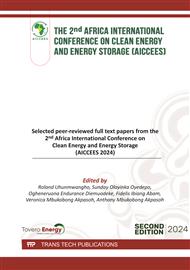[1]
Ntinyari, W., & Gweyi-Onyango, J. P. (2020). Greenhouse gas emissions in agricultural systems and climate change effects in Sub-Saharan Africa. In African handbook of climate change adaptation (pp.1-25). Cham: Springer International Publishing.
DOI: 10.1007/978-3-030-42091-8_43-1
Google Scholar
[2]
Soeder, D. J., & Soeder, D. J. (2021). Fossil fuels and climate change. Fracking and the Environment: A scientific assessment of the environmental risks from hydraulic fracturing and fossil fuels, 155-185.
DOI: 10.1007/978-3-030-59121-2_9
Google Scholar
[3]
Allan, R. P., Arias, P. A., Berger, S., Canadell, J. G., Cassou, C., Chen, D., ... & Zickfeld, K. (2023). Intergovernmental Panel on Climate Change (IPCC). Summary for Policymakers. In Climate change 2021: The physical science basis. Contribution of Working Group I to the Sixth Assessment Report of the Intergovernmental Panel on Climate Change (p.332). Cambridge University Press.
DOI: 10.1017/9781009157896
Google Scholar
[4]
Camarasa, C., Mata, É., Navarro, J. P. J., Reyna, J., Bezerra, P., Angelkorte, G. B., ... & Yaramenka, K. (2022). A global comparison of building decarbonization scenarios by 2050 towards 1.5–2 C targets. Nature Communications, 13(1), 3077.
DOI: 10.1038/s41467-022-29890-5
Google Scholar
[5]
Meinshausen, M., Lewis, J., McGlade, C., Gütschow, J., Nicholls, Z., Burdon, R., ... & Hackmann, B. (2022). Realization of Paris Agreement pledges may limit warming just below 2 C. Nature, 604(7905), 304-309.
DOI: 10.1038/s41586-022-04553-z
Google Scholar
[6]
Ding, H., Zhang, Y., Dong, Y., Wen, C., & Yang, Y. (2023). High-pressure supersonic carbon dioxide (CO2) separation benefiting carbon capture, utilization, and storage (CCUS) technology. Applied Energy, 339, 120975.
DOI: 10.1016/j.apenergy.2023.120975
Google Scholar
[7]
Boretti, A. (2022). The perspective of enhanced geothermal energy integration with concentrated solar power and thermal energy storage. Energy Storage, 4(1), e303.
DOI: 10.1002/est2.303
Google Scholar
[8]
Pingkuo, L., & Xue, H. (2022). Comparative analysis on similarities and differences of hydrogen energy development in the World's top 4 largest economies: a novel framework. International Journal of Hydrogen Energy, 47(16), 9485-9503.
DOI: 10.1016/j.ijhydene.2022.01.038
Google Scholar
[9]
Ahmed, Z., & Wang, L. (2021). "Utilization of Geothermal Energy for Drying Agricultural Products." Renewable Energy Applications, 15(3), 210-225.
Google Scholar
[10]
Muraoka, H. (2022). Geothermal energy. In Handbook of climate change mitigation and adaptation (pp.809-836). Cham: Springer International Publishing.
DOI: 10.1007/978-3-030-72579-2_35
Google Scholar
[11]
Lund, J.W., & Boyd, T.L. (2016). Direct utilization of geothermal energy 2015 worldwide review. Geothermics, 60, 3-23.
DOI: 10.1016/j.geothermics.2015.11.004
Google Scholar
[12]
Glassley, W. E. (2014). Geothermal energy: Renewable energy and the environment (2nd ed.). CRC Press.
Google Scholar
[13]
Bamisile, O., Cai, D., Adun, H., Taiwo, M., Li, J., Hu, Y., & Huang, Q. (2023). Geothermal energy prospect for decarbonization, EWF nexus and energy poverty mitigation in East Africa; the role of hydrogen production. Energy Strategy Reviews, 49, 101157.
DOI: 10.1016/j.esr.2023.101157
Google Scholar
[14]
Kong'ani, L. N. S., & Kweyu, R. M. (2022). Toward Sustainable Implementation of Geothermal Energy Projects–The Case of Olkaria IV Project in Kenya. In Geothermal Energy-Challenges and Improvements. IntechOpen.
DOI: 10.5772/intechopen.107227
Google Scholar
[15]
Mburu, C. (2016). Geothermal development in Kenya: A country update. Proceedings of the 6th African Rift Geothermal Conference. Addis Ababa, Ethiopia.
Google Scholar
[16]
Sondakh, G. G. (2022). Life Cycle Assessment of the Geothermal Power Plant in the Patuha Geothermal Field, Indonesia. Energy.
Google Scholar
[17]
Muthuri, F. M. (2024). KENYA ELECTRICITY GENERATING COMPANY PLC 80.3 MWe OLKARIA VII GEOTHERMAL POWER PLANT ENVIRONMENTAL AND SOCIAL IMPACT ASSESSMENT STUDY REPORT.
Google Scholar
[18]
Mwirigi, J., & Kinyua, J. (2020). "The Impact of Geothermal Energy on Fish Farming in Kenya." International Journal of Aquaculture, 12(2), 67-78.
Google Scholar
[19]
Mburu, C. (2016). Geothermal development in Kenya: A country update. Proceedings of the 6th African Rift Geothermal Conference. Addis Ababa, Ethiopia.
Google Scholar
[20]
Mwangi, M. (2010). Country update report for Kenya 2005-2009. Proceedings of the World Geothermal Congress 2010, Bali, Indonesia.
Google Scholar
[21]
International Renewable Energy Agency (IRENA). (2020). Geothermal: The answer to decarbonizing the energy sector. https://www.irena.org/publications/(2020)
Google Scholar
[22]
Spittler, N., Davidsdottir, B., Shafiei, E., & Diemer, A. (2021). Implications of renewable resource dynamics for energy system planning: The case of geothermal and hydropower in Kenya. Energy Policy, 150, 111985.
DOI: 10.1016/j.enpol.2020.111985
Google Scholar
[23]
Omenda, P., Mangi, P., Ofwona, C., & Mwangi, M. (2020). Country update report for Kenya 2015-2019. In Proceedings of World Geothermal Congress.
Google Scholar


